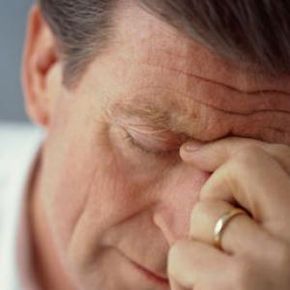Headaches are one of the most common medical complaints -- nearly everyone gets a headache at some point. Over 45 million Americans (about one in six) suffer chronic headaches each year. Headaches therefore have a big economic impact -- when you have a throbbing pain in your head, it's hard to work. The cost of these headaches in absenteeism and medical expenses is estimated as high as $50 billion per year.
A headache is a pain sensed in the nerves and muscles of the head and neck, as well as the meninges (the membranous coverings of the brain and spinal cord). Your brain itself cannot sense pain, so a headache has nothing to do with your brain hurting. It is really a pain somewhere around your brain, being picked up by nerve endings located in your head.
Advertisement
There are two main reasons why people get headaches, and doctors therefore classify headaches into two broad categories: primary and secondary.
- Primary headaches are not associated with any underlying medical condition.
- Secondary headaches are associated with medical conditions like infections, fever, head injury, hypoglycemia, tumors, dental conditions or increased pressure in the skull and/or sinuses (sinus headaches).
There are three main causes for primary headaches:
- Migraine - Migraine headaches can be caused by reduced blood flow to various areas of the cerebral cortex. Symptoms of migraines include sensitivity to light and noise, nausea, vomiting and intense throbbing pain that is usually on one side of the head. A neurotransmitter, serotonin, is thought to be involved in migraines because many of the drugs used to treat migraines alter the binding of serotonin to various receptors.
- Tension - Tension headaches are caused by muscular strains in the head and neck and/or emotional stress. Tension headaches are usually dull, steady, aching pains on both sides of the head. Sometimes, tension headaches develop into throbbing pains, leading researchers to believe that they may be closely related to migraines. Eye strain (poor vision) can trigger frequent tension headaches.
- Cluster - Cluster headaches are headaches that occur repeatedly over a period of weeks or even months. Cluster-headache pain usually occurs on one side of the head and is centered around the eye. The causes of cluster headaches are unknown, but may be related to changes in blood flow because substances that affect blood flow, such as alcohol, can trigger cluster headaches.
Primary headaches can also be caused by too much blood flow. For example, if you have read How Caffeine Works, you know that caffeine reduces blood flow in the brain. Some pain relievers contain caffeine to take advantage of this effect. If you have been taking caffeine every day and you stop, you can get an incredible headache because of the increased blood flow in your brain.
Secondary headaches result from some other problem with your body. For example, How Viruses Work talks about why you get a headache (and other pains) when you have the flu. Once you eliminate the disease, you eliminate the secondary headaches.
Most headache pain can be treated with over-the-counter medications such as aspirin, acetaminophen (Tylenol), ibuprofen (Motrin) and other non-steroidal anti-inflammatory drugs. As mentioned above, migraines have been helped by drugs that block serotonin, such as sumatriptan (Imitrex). Cluster headaches have been treated with sumatriptan, steroids (Migranal) and narcotics.
If you experience chronic or frequent headache pain, see your physician -- it may be a symptom of an underlying medical condition.
For more information on headaches, pain and related topics, check out the links on the next page.
Advertisement


